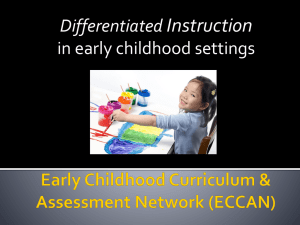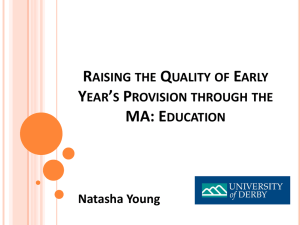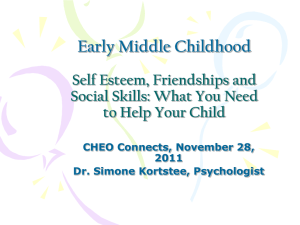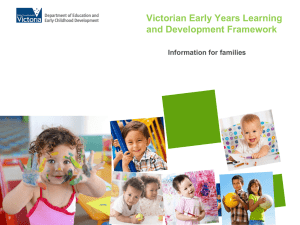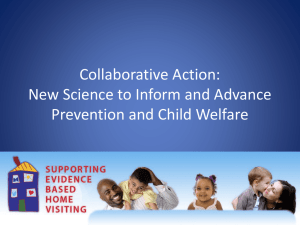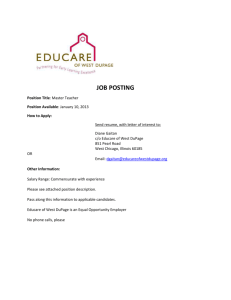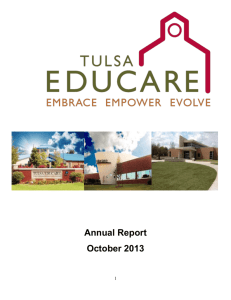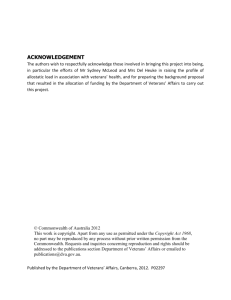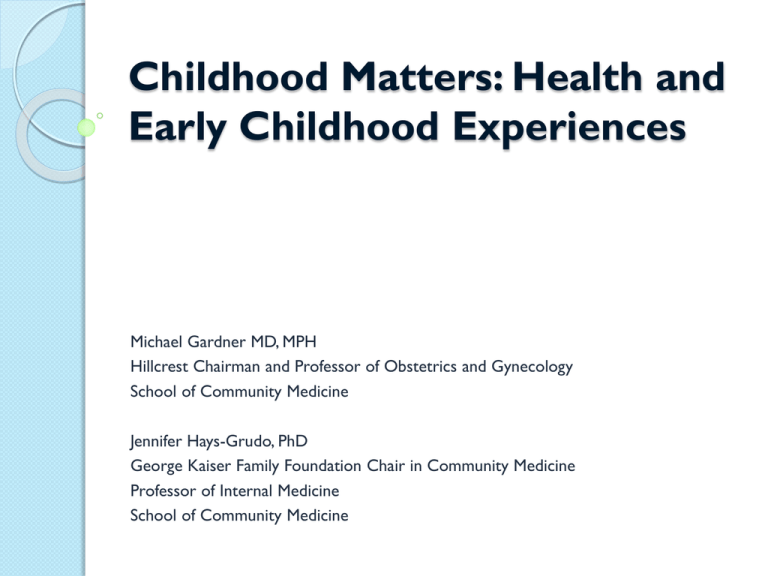
Childhood Matters: Health and
Early Childhood Experiences
Michael Gardner MD, MPH
Hillcrest Chairman and Professor of Obstetrics and Gynecology
School of Community Medicine
Jennifer Hays-Grudo, PhD
George Kaiser Family Foundation Chair in Community Medicine
Professor of Internal Medicine
School of Community Medicine
Welcome to the womb…
You really can blame your mother?
Developmental Origins of Adult Health
and Disease (DOHaD)
Barker hypothesis (Barker & Osmond, 1986; Barker, 1995)
◦ Fetal undernutrition associated with adult obesity, CVD and type II
diabetes (Law et al., 1992; Sayer et al., 2004)
◦ Fetal undernutrition + rapid “catch-up growth” (Ong, 2006; Stettler et al., 2003,
2005)
Thrifty phenotype (Hales & Barker, 2001)
◦ Adaptive response for deprived pretnatal environment maladaptive for
postnatal environment
Developmental Origins of Adult Health and Disease
(DOHaD) (Gluckman et al 2005;Taylor & Poston, 2007)
◦ Fetal environment either nutritionally deprived or over-rich increases risk
for child and adult obesity and its sequelae (Catalano, 2003; Oken & Gillman, 2003;
Ehrenberg et al., 2004)
Barker Hypothesis
Based on medical archives from Preston,
Hertfordshire, and Sheffield, England
16,000 men and women born in
Hertfordshire, 1911- 1930:
● 2-fold increase in coronary heart
disease from largest to smallest BW
● Impaired GT increased from 14% to 40%
Barker, et al
Clin Sci 1998; 115:118
Death Rates From Coronary Artery
Disease According to Birthweight
Prevelance of Type II DM and Impaired
Glucose Tolerance in Men Age 59-70
The Nurses Health Study
● 121,701 RNs aged 30 - 55 yrs,
followed since 1976
● BW self-reported, validated by
birth certificate
Rich-Edwards, et al
BMJ 1997; 315:396
The Nurses Health Study
< 2269 g
2268-2495 g
2496-3175 g
3176-3856 g
3857-4536 g
≥ 4537 g
CAD
MI
Stroke
1.32
1.15
1.02
(ref)
0.92
0.68
1.29
0.95
0.92
(ref)
0.92
0.68
2.29
1.38
1.25
(ref)
0.99
0.66
Rich-Edwards, et al
BMJ 1997; 315:396
Thrifty Phenotype Hypothesis
During periods of starvation, the fetus reduces
insulin secretion, and
increases peripheral insulin resistance, thus
directing more glucose to the brain and heart,
and less to skeletal muscle, etc.
Hales and Barker
Diabetologica 1992; 35: 595
What happens inside matters
outside
Antenatal stress associated with:
Decreased cognitive function
◦ Quebec Ice Storm -1998 - loss of electricity &
water for up to 5 weeks
Children had lower MDI scores
Lower language development scores
These held when controlling for Ob complications,
birth weight , post partum depression (LaPlante et al,
2004)
Maternal exposure to traumatic events associated with:
◦ Schizophrenia (OR – 1.5 in cohort from Dutch famine)
◦ Depression in adulthood
Chinese Famine
Rate of Schizophrenia
Year of
birth
1959
Adjusted risk
P
0.89 (0.78-1.03)
0.13
1960
2.30 (1.99-2.65)
<0.001
1961
1.93 (1.68-2.23)
<0.001
1962
0.95 (0.87-1.04)
0.28
St. Clair, et al
JAMA 2005; 294:557
Childhood behaviors – Mom’s input
In pregnant women in the top 15% of
symptoms of anxiety at 32 weeks
◦ Children had double the risk of behavioral
problems at age 4 and 7
◦ Higher risk for ADHD, depression or conduct
disorders
◦ Attributable risk may be as high as 15%
◦ If true – economic consequences for special
education and even incarceration are stunning
◦ annual societal ‘‘cost of illness’’ for ADHD is
estimated to be between $36 and $52 billion –
prenatal stress accounting for $5-7 billion per year
Pay attention Oklahoma!
How?
Epigenetic modifications represent a potential way that
“metabolic programming” occurs
Alteration in the hypothalamic-pituitary-adrenal axis
involving:
◦ Mobilizing energy stores
◦ Response to stress
◦ Inhibiting inflammatory responses during stress
Post natal stress is cumulative with prenatal stress
leading to increased vulnerability to stressors
Prenatal stress can lead to impaired fetal growth
Attention disorders and increased anxiety observed
Metabolic “Programming” via
Genetic Imprinting
● Imprinting turns gene off
● Gene dosage effect- only one gene operational
● Some imprinting reflects gender of transmitting
parent
● Many imprinted genes involve metabolism
i.e. Igf 2 , Igf 2r, H19
Programmed to be ill?
Tulsa - We’re Number 1!!
Statistics published in Newsweek
Tulsa, Oklahoma
Smokers: 24.6%
Cigarettes per day: 16.2
Tried to quit with gum: 26.9%
Tried to quit with patch: 32.8%
Tried to quit with support program: 7.4%
Smoking in Pregnancy
Decreased fetal growth
Increase in Preterm Birth
Increase in placental abruption
Children Born with IUGR (< 2.5K):
↓ Nephron number
Fewer glomeruli
↓ Renal volumes
Adult glomeruli : 1,400,000 / kidney in controls
700,000 / kidney in HTN
Rostand Nephol Dial Transplant
2003; 18:1434
Smoking effects
Children exposed to tobacco prenatally:
◦ Decreased memory skills at age 6
◦ Deficits in auditory processing
Effects more pronounced then children
who were exposed prenatally only to
marijuana smoking (those children have
decreased “executive function”)
Alcohol
Fetal Alcohol Syndrome – associated with
6 or more drinks per day
Leads to neurologic impairment
Post natal growth restriction
Microcephaly
Alcohol – other effects
alcohol ingestion during pregnancy
represents a risk factor in terms of later
alcohol-related problems in offspring
hypothesis that low to moderate levels of
maternal ethanol intoxication during late
pregnancy set the opportunity for fetal
learning about ethanol
Meth exposure
Meth-exposed children scored lower on
measures of visual motor integration,
attention, verbal memory and long-term
spatial memory
children exposed to Meth prenatally
exhibit smaller subcortical volumes
Maternal Obesity
Higher rates of macrosomia
Higher rates of pregnancy induced
hypertension
Higher rates of Gestational Diabetes (a
precursor for Type 2 DM)
DULCE Program
Provides culturally competent group
prenatal care for Diabetic mothers
Education emphasizes diet and life style
changes (i.e. just a 20 minute walk a day
can smooth out blood sugars)
Teaches self reliance in managing DM
Early review of findings shows a decrease
in LGA babies in the Group prenatal care
as compared to traditional care
SUMMARY
●The intrauterine environment exerts a
permanent influence on postnatal metabolism
and growth
●The mother’s fetal life can affect the
development of her own offspring
●Influential factors include calories, content of
diet, micronutrients, stressors
Welcome to your childhood…
Poverty, children and health: Oklahoma
Two complementary theories
Critical periods (latency model)
◦ Barker hypothesis
◦ Organogenesis
Fewer beta cells in pancreas – type 2 diabetes
Fewer nephrons - hypertension
Cumulative experiences (pathways
model)
◦ Allostasis and allostatic load
◦ Behavioral responses
Poverty and health
Childhood SES
Critical
periods
Adult SES
Accumulation
of insults
Childhood health
Adult health
Conroy K et al. JDBP 2010;31:154-160
Allostasis and Allostatic Load
The stress response and development of allostatic load are illustrated. Perception of
stress is influenced by one’s experiences, genetics, and behavior. When the brain
perceives an experience as stressful, physiologic and behavioral responses are
initiated leading to allostasis and adaptation. Over time, allostatic load can
accumulate, and the overexposure to neural, endocrine, and immune stress
mediators can have adverse effects on various organ systems, leading to disease.
McEwen 1998
Let’s look at that again
Adverse Childhood Experiences
(ACE) study
Felitti V, Anda R et al. Relationship of childhood abuse and household
dysfunction to many of the leading causes of death in adults. Am J Prev Med
1998;14:245-258.
9,508 Kaiser-Permanente adults
7 categories of childhood exposure
◦ Abuse: psychological, physical, sexual
◦ Dysfunction: substance abuse, mental illness, domestic violence,
criminality
10 health risk factors
◦ Smoking, obesity, inactivity, depressed mood, suicide attempts,
alcoholism, drug abuse, parenteral drug abuse, >50 sexual partners,
history of STDs.
Disease conditions:
◦ Ischemic heart disease, cancer, stroke, COPD, diabetes, hepatitis,
skeletal fractures, general health rating
ACE results
Childhood stressors linked to adult health risk behaviors
Risk Factors
Stressors
0
>4
0
56%
1%
>4
14%
7%
Childhood stressors linked to disease conditions (OR)
diabetes (1.6), COPD (3.9), fractures (1.6), hepatitis (2.3),
self-rated poor health (2.2)
Strong dose-response relationship between number of
childhood stressors and each of 10 behavioral RFs (p<.05)
and for heart disease, cancer, COPD, hepatitis, fractures,
poor self-rated health (not for stroke or diabetes).
More recent follow-up
At least 1 ACE was reported
by 64% of respondents.
For persons with ≥ 4 ACEs,
the risk of panic reactions,
depressed affect, anxiety,
and hallucinations were
increased 2.5-, 3.6-, 2.4
and 2.7-fold, respectively
The mean number of comorbid outcomes in the study
sample was 2.1 (range: 0–14); means are adjusted for
age, sex, race, and educational attainment. The trend in
the means is significant (P<0.0001); vertical error bars
represent 95% confidence intervals
Anda et al Eur Arch Psychiatry Clin
Neurosci (2006) 256 : 174–186
Implications of ACE Study
“Clearly, further research and training are needed to help
medical and public health practitioners understand how social,
emotional, and medical problems are linked throughout the
lifespan.
Such research and training would provide physicians with the
confidence and skills to inquire and respond to patients who
acknowledge these types of childhood exposures.
The magnitude of the difficulty of introducing the requisite
changes into medical and public health research, education, and
practice can be offset only by the magnitude of the implications
that these changes have for improving the health of the nation.”
Felitti et al.. Am J Prev Med
1998;14:245-258.
Health and stress in Tulsa families
Tulsa Educare – 2 sites
Yearly parent interviews at
◦ Health issues
Child’s health
“What happened to you last
year” – 18 items
◦
247 parents
Interviews conducted by family
support specialists
Data analyzed for links to child
health
Allergies
Asthma
Eczema
Obesity (0)
4 categories of stressors
Financial
Relationship
ACE
Life Changes
Preschool health by demographics
Total
No health
issue
At least one
health issue
Gender
Male
141 (57.1%)
101 (59.8%)
40 (51.3%)
Female
106 (42.9)
68 (40.2%)
38 (48.7)
2.5 (1.2)
2.5 (1.3)
2.3 (1.1)
Age: M (SD)
Race
White
27 (10.9%)
17 (10.1%)
10 (12.8%)
Black
94 (38.1%)
50 (29.6%)
44 (56.4%)
Biracial
17 (6.9%)
11 (6.5%)
6 (7.7%)
Other*
109 (44.1%)
91 (53.8%)
18 (23.1%)
Ethnicity
Hispanic
105 (42.5%)
86 (50.9%)
19 (24.4%)
Non-Hispanic 142 (57.5%)
83 (49.1%)
59 (75.6%)
*95 of the 105 Hispanic parents selected race as “other”
X2
p
1.6
0.211
1.1
0.255
22.0
<0.001
15.4
<0.001
Family stress and child health
81% of healthy
children had at
least one stressor
(M=2.6 [SD=2.4])
95% of children with
a health problem
had at least one
stressor (M=3.5
[SD=2.3])
(all p values < 0.05)
Health problem by stress category
90
80
70
60
50
40
30
20
10
0
0
>1
Children with asthma,
allergies and eczema
were more likely to
have experienced a
family stress in the
past year
Children with health
problems were more
likely to have stressors
from multiple
categories (2.1) than
healthy children (1.5)
Tulsa Children’s Project
Based at Tulsa Educare
Community-based
participatory research
Multiple partners
Interdisciplinary design
Highly integrated set of
interventions
Funded by George Kaiser
Family Foundation
http://youtu.be/3AKYdr2VGxo
TCP Partners
Annie Van Hanken
Monica Basu
Caren Calhoun,
Vicki Wolfe
Master Teachers
Jack Shonkoff Bill
Beardslee Snow,
Yoshikawa
Ruth Slocum
Elizabeth Miranda
Chris King
Bob Glover
Jennifer Hays-Grudo
Jerry Root
Juell Homco
Julie Miller-Cribbs
Natalie O’Reilley
Trishia Pratt
Candice Weed
Diane Horm,
Lisa Monroe
Intervention Model
Children prepared
to succeed in school
(foundation for lifelong success)
Lowincome
families
Children
(0-5)
enrolled
in Tulsa
Educare
Lowopportunity
communities
Medical Home
Early
Childhood
Education
Nutrition
SocialEmotional
Health
Physical
activity
EduCareers:
Adult Education
and Workforce
Training
Healthy Competent
Children in Healthy
Competent
Families
Parents actively
improving their own
& their children’s life
circumstances
Economic security
Reduction in intergenerational
poverty
Current
Situation
Intervention
Short-term
outcomes
Long-term
outcome
Integrated components
Improve quality of classroom experience
◦ Enhance curriculum and
◦ Professional development for teachers and staff
Provide opportunities for parents
◦ Adult education
◦ Workforce training
Promote physical health
◦ Health promotion for parents and staff
◦ Improved access to care through on-site clinic
Early Childhood Education
Developed and implemented new curriculum – Catherine
Snow from Harvard Graduate School of Education
Conducted monthly full or half-day professional
development sessions with master teachers and Harvard
consultants
Assisted teachers in developing plans for improved
outdoor play program
Expected long-term outcomes:
improved language skills in children
improved effectiveness in teachers
Health and Health Promotion
Dr. Charlie Homer/NICHQ coaching
Increased clinic hours
Hired bilingual staff
Health promotion
◦ Weekly yoga & Zumba classes
(parents)
◦ Bi-monthly yoga classes (staff)
◦ Monthly parent nutrition “make and
take” classes
◦ Monthly health workshops
◦ RECESS instructors in class
Expected long-term outcomes:
Increase utilization of clinic within community
Improved health and fitness in Educare community
EduCareers:
adult education and workforce
training for parents
Three options for parents:
◦ Nursing cohort: 9
◦ Adult Education
ESL: 30
GED: 8
◦ Ind’l Career Coaching: 4
Established partnerships:
◦ TCC and TTC
◦ Workforce Oklahoma
◦ Union Public Schools
Support meetings, gas cards,
incentives, child care
Family Literacy class
Expected long-term outcomes:
Increased earned income/career opportunities in parents
Increased educational achievement in both generations
Nursing cohort
9 of 9 passed certification exam for CNA
8/9 completing CNA III classes at TCC
7/9 passed first block of LPN classes (Medical Terminology,
Anatomy & Physiology 1 and 2) with A averages
Will start clinical blocks Fall 2011
Mental health
Emphasized socioemotional development in curriculum
Taught teachers to recognize and address parental depression
(Bill Beardslee’s program Family Connections)
Built relationships with Educare teachers, staff, parents and
community
Assessed staff perceptions of Educare (physical, socio-emotional
safety in variety of contexts)
Trained nursing cohort in life skills (building relationships,
solving problems, resolving conflict, etc.)
Provided additional mental health support for parents and
children as appropriate (K. Coon)
Expected long-term outcomes:
Improve interactions among teachers, parents, peers & children
Reduce negative impact of depression on children
Reduce staff absences and turnover
Welcome to your future…
tulsa county
2000 median income: $41,666
gini coefficient
denmark
eur. union
canada
usa
oklahoma
mexico
tulsa county
swaziland
city of tulsa
peru
namibia
24.7
31.0
32.1
45.0
46.0
46.1
47.4
50.4
50.4
52.0
76.0
Data from the US Census Bureau and the CIA Factbook.
Social determinants of health
The World Health Organization
Commission defined social
determinants of health as the
conditions in which people are
born, grow, live, work and age,
including the health system.”
“The structural determinants
and conditions of daily life
constitute the social
determinants of health and are
responsible for a major part of
health inequities between and
within countries”
(WHO Commission on Social Determinants
of Health, Final Report, 2008).
WHO Commission on Social Determinants of Health, final report, 2008.
Interventions to address SDH
Downloading: what do we know? (health outcomes
tied to SDH: education and income)
Seeing fresh: what are we not seeing? (programs
don’t address root causes, not coordinated)
What do we sense is needed? (partners,
communication, trust)
What are we called we do? (build relationships,
develop organic programs)
What would it look like? (user friendly, responsive)
Let’s try it.
Usual approach to health problems
values
governments
insurers
health
care
churches
Typical
Disciplines
family
built
environment
schools
genes
Clinical medicine
Behavioral science
Public health
Nutrition
Exercise science
behavior
Individual
physical
resources
Environment
Systems
retailers
norms
Policy
Culture
workplace
school boards
regulatory
agencies
Ecological model of intervention
attitudes
government
agencies
funders
Academic
Disciplines
economic
environment
health
care
physical
resources
churches
family
Community partners
schools
Individual
retailers
built
environment
Systems
Environment
norms
Policy
school boards
Culture
values
Behavioral sciences
Clinical medicine
Health promotion
Education
Social work
Economics
Public health
Public policy /law
Architecture/ Urban
design
Marketing & media
TCP: Highly integrated engagement of
community partners with common goals
Partners
Educare admin,
staff and parents
Psychologists &
social workers
built
environment
churches
family
economic funders attitudes
schools environment
health
school boards
Individual
physical
care
values
resources
vendors
government
Systems
agencies norms
Environment
Policy
Culture
Physicians
& mental health
Clinical medicine &
health promotion
Education
Social work
Economics
Public policy /law
Architecture/ Urban
design
Marketing & media
Post-natal nutritional programming
Gluckman &
Hanson,
2004
Developmental Origins of Adult Health and
Disease Hypothesis
From McMillen & Robinson 2005
McMillen & Robinson 2005


